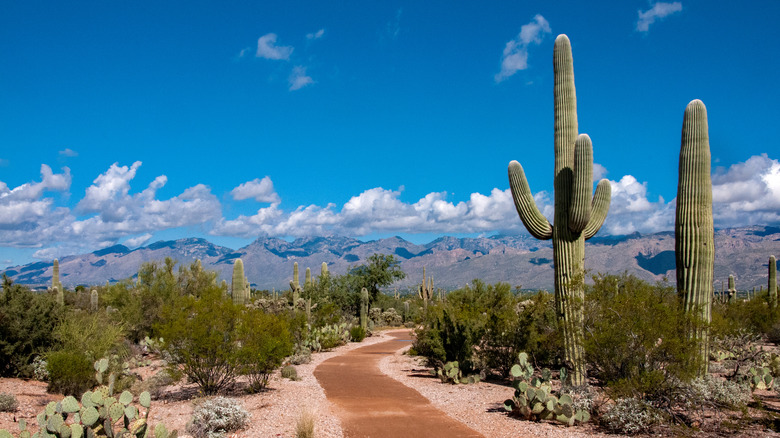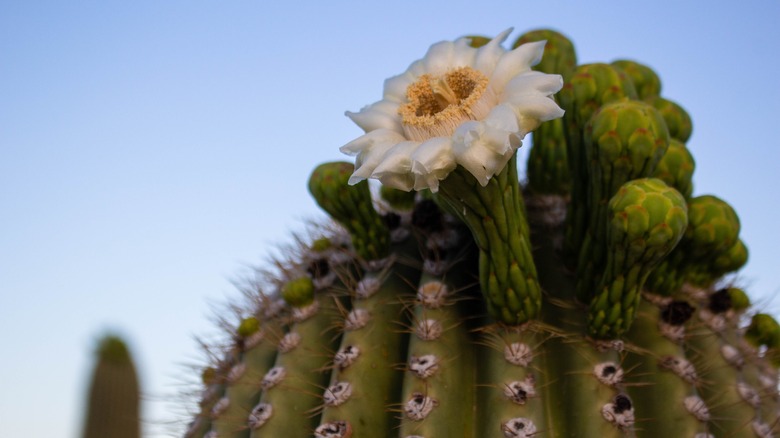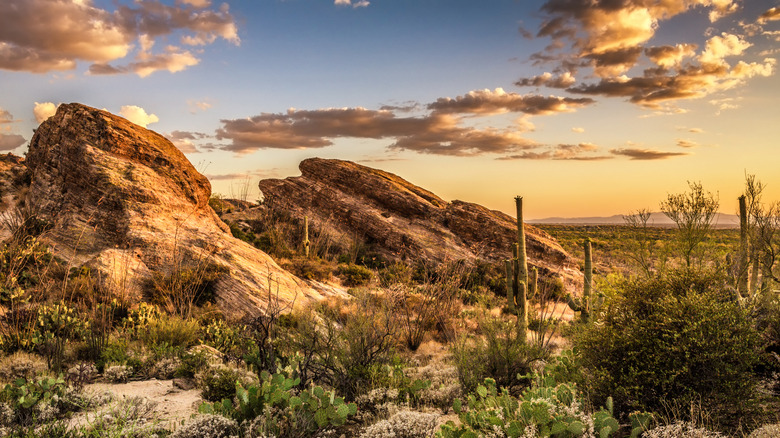This Underrated National Park Is An Arizona Gem With Breathtaking Desert Scenery
Pop quiz: What living being is hundreds of years old, weighs up to 6 tons, stands 45 feet tall, and can grow up to 25 arms? That would be the mighty Saguaro Cactus. Saguaro National Park (pronounced sa-WHA-ro, with no "g" sound) is named after the giant, columnar cactus whose ribbed, dusty green arms reach for the sky. Once at risk, there are now 2 million Saguaro in the 91,000-acre park, located in a part of the Sonoran Desert known as the Arizona Upland.
This region has five seasons instead of four: Spring, the dry "foresummer," the summer monsoons, fall, and winter, or just think of them as really hot, hotter, hottest, really hot again, then cool (surprisingly, winter here can even see a light dusting of snow). Foresummer, in May and June, is very dry and very hot, but it's also the season when crowns of white flowers appear on the night-blooming saguaro cacti. So, every season has something to offer (just watch that foresummer/summer heat).
The Park is split into two parts: The Tucson Mountain District to the west of Tucson and the Rincon Mountain District to the east. The two are less than an hour apart, and each has its own charms. And if you anticipate visiting often, or heading for other national parks within a year's time — like if you're planning the perfect U.S. road trip — here's how to figure out if an America the Beautiful National Pass is worth the price for you.
Saugaro's west side is all about those cacti
If you only have time for a quick visit, the 6-mile Bajada Loop Drive offers abundant, cactus-filled vistas. "I went at sunrise, and it was truly amazing to look out and see a forest of Saguaro trees," one Tripadvisor visitor writes. "Each tree had their own personality and was spectacular in its own right." Highlights include the Signal Hill Picnic area, with the short trail to the Signal Hill Petroglyphs, some over 1,000 years old, and the Valley View Overlook Trail, which rises less than a mile to offer views of the vast Avra Valley that will fill you with awe at the sheer scale of the desert.
Driving, hiking, and biking are great ways to get out and see this side of the park, but however you roll, the west side is all about getting up close and personal with those magnificent cacti. Saguaro can take eight years to grow their first inch, and decades to reach the heights prized by landscapers — one reason cutting down a saguaro is a felony in Arizona, even on your own property. Rangers at the park even began microchipping the cacti in 2018 to discourage poachers, as multi-armed showpieces can sell for thousands. They are prized by Native cultures, too: In June, just before the monsoons begin, members of the Tohono O'odham Nation harvest the pulpy red fruit from the park's cacti in a tradition going back thousands of years.
Saguaro's east side is for hikers
Like some of Arizona's other lesser-known gems you can visit, Saguaro's less-visited east side has fewer cacti but is a hiker's paradise. It is more mountainous, and the only part where you can backpack (the park's only campsites require at least a 4-mile hike to reach). But the 10-mile Cactus Forest Trail is a flat and easy day hike, and in early spring, you'll see a riot of desert wildflowers, the beauty of which no camera phone can quite capture.
Just remember: Most desert animals are crepuscular, meaning they are active at dawn and dusk, hiding away for a siesta during the hottest part of the day, between 10 a.m. and 4 p.m. In the desert, you should be a crepuscular animal, too! Follow the rangers' hiking safety guidelines for tips on how much water to carry and when to go.
A favorite sunset-watching spot here is the overlook at Javelina Rocks, a particularly photogenic set of striated outcroppings. Sunset and sunrise are also the most likely times to spot a herd of human-shy Javelinas in the distance, if you're lucky. These peccaries also like the area around the Rincon Mountain Visitor Center, which is your jumping-off point for the 9-mile Cactus Forest Loop Drive. This loop begs to be ridden on a bike, and BikeTucson will deliver rental bikes right to the trailhead.


